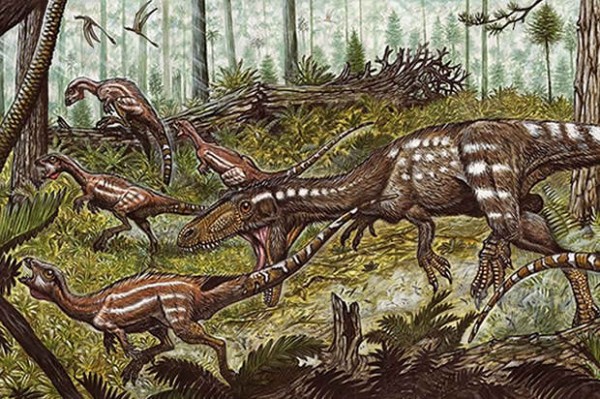Meet the Tachiraptor, the Carnivorous Dinosaur that Survived the Mass Extinction
| Kizha T. Trovillas | | Oct 09, 2014 04:05 AM EDT |
(Photo : Maurilio Oliveira)
A new species of dinosaur that apparently preyed on other animals has been discovered in Venezuela. The finding could shed light on how species survived a horrific mass extinction some 200 million years ago.
To acknowledge history, the international team of paleontologists called the new dino Tachiraptor admirabilis. The generic name derives from Tachira, a state in Venezuela where the remains were unearthed and raptor, a Latin word for "thief," which describes the dinosaur's predatory habit.
Like Us on Facebook
The second name honors the "Admirable Campaign" of the South American liberation hero, Simon Bolivar. The campaign played a strategic role that led to Venezuela's liberation from Spanish rule in 1813.
The Tachiraptor fossils were found in the northernmost part of the Andes Mountains at the western border of Venezuela.
As yet, the only bones discovered are two leg bones: shinbone and a partially fractured hip bone from two different individuals. Nevertheless, paleontologists were able to determine the dinosaur was about 1.5 meters long from nose to tail.
Its size and shape tag the creature as a meat-eating theropod. But the bones are different enough to indicate Tachiraptor as new species, confirmed vertebrate paleontologist Max Langer of the University of Sao Paulo in Brazil.
Using radioactive dating, paleontologists estimated the age of the fossils at about 200 million years old. The results place the dinosaur in the Jurassic period, just after the massive extinction event had ended the early Triassic period. It also means this dinosaur could be a probable ancestor of bigger dinosaurs like T. rex.
"These survivors of the Triassic-Jurassic mass extinction were the "ground zero" for the theropod evolution," said another vertebrate paleontologist, Thomas Holtz from the University of Maryland.
The find also proposes the idea that the equatorial belt of Pangaea may have contributed a big role in the theropod evolution. Previous research suggested the region was too inadequate for dinosaurs to live in during the Jurassic period.
More fossils from the region could help paleontologists flesh out the dinosaur family tree. Although this might be a tedious process, paleontologists are still planning to go back to Venezuela to search for more bones.
The finding was published October 8 in the journa,l Royal Society Open Science.
©2015 Chinatopix All rights reserved. Do not reproduce without permission
EDITOR'S PICKS
-

Did the Trump administration just announce plans for a trade war with ‘hostile’ China and Russia?
-

US Senate passes Taiwan travel bill slammed by China
-

As Yan Sihong’s family grieves, here are other Chinese students who went missing abroad. Some have never been found
-

Beijing blasts Western critics who ‘smear China’ with the term sharp power
-

China Envoy Seeks to Defuse Tensions With U.S. as a Trade War Brews
-

Singapore's Deputy PM Provides Bitcoin Vote of Confidence Amid China's Blanket Bans
-

China warns investors over risks in overseas virtual currency trading
-

Chinese government most trustworthy: survey
-

Kashima Antlers On Course For Back-To-Back Titles
MOST POPULAR
LATEST NEWS
Zhou Yongkang: China's Former Security Chief Sentenced to Life in Prison

China's former Chief of the Ministry of Public Security, Zhou Yongkang, has been given a life sentence after he was found guilty of abusing his office, bribery and deliberately ... Full Article
TRENDING STORY

China Pork Prices Expected to Stabilize As The Supplies Recover

Elephone P9000 Smartphone is now on Sale on Amazon India

There's a Big Chance Cliffhangers Won't Still Be Resolved When Grey's Anatomy Season 13 Returns

Supreme Court Ruled on Samsung vs Apple Dispute for Patent Infringement

Microsoft Surface Pro 5 Rumors and Release Date: What is the Latest?










